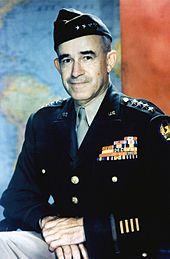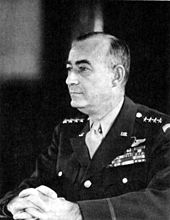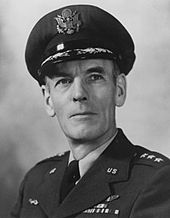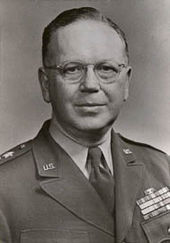- The class the stars fell on
-
Contents
"The class the stars fell on" is an expression used to describe the United States Military Academy class of 1915.[1] In the U.S. Army, the insignia reserved for generals is one or more stars. Of the 164 graduates that year, 59 (36%) attained the rank of general, the most of any class in the history of the United States Military Academy at West Point, New York, hence the expression.[2] Two reached the rank of five-star General of the Army, second only to General of the Armies. There were also two four-star generals, seven three-star lieutenant generals, 24 two-star major generals and 24 one-star brigadier generals.[3] One of the five-star generals went on to become President of the United States.
Generals of the class
Rank Name Rank in class Notes References 
Omar N. Bradley 44 Commanded 82nd Infantry Division (1942), 28th Infantry Division (1942), II Corps (1943), First Army (1944), Twelfth Army Group (1944–1945) Chief of Staff of the United States Army (1948–1949), Chairman of the Joint Chiefs of Staff (1949–1953) [1][4] 
Dwight D. Eisenhower 61 Chief of Staff of the United States Army (1945–1948), Supreme Allied Commander Europe (1942, 1943–1945, 1949–1952), Supreme Allied Commander, North African Theater of Operations (1942–1943), President of the United States (1953–1961) [1][5] 
Joseph T. McNarney 41 Deputy Chief of Staff, U.S. Army (1942–1944), Supreme Allied Commander, Mediterranean Theater of Operations (1944–1945), Commanded U.S. Forces in Europe (1945–1947) [4][6] 
James Van Fleet 92 Commanded 4th Infantry Division, 90th Infantry Division, III Corps in World War II; U.S. Eighth Army in the Korean War (1951–1953) [7][8] 
Henry Aurand 20 Commanded 6th Service Command (1942–1944), Deputy Chief Ordnance Officer, European Theater of Operations (1944), Commanded Services of Supply China Theater (1944–1945), U.S. Army Pacific (1949) [9][10] 
Hubert R. Harmon 103 Commanded Sixth Air Force (1942–1943, 1946–1947), Thirteenth Air Force (1943–1944), Superintendent of the United States Air Force Academy (1954–1956) [12][13] 
Stafford LeRoy Irwin 40 Commanded 5th Infantry Division, XII Corps, V Corps, U.S. Forces Austria (1950–1952) [4][14] 
Thomas B. Larkin 21 Chief of Staff, Services of Supply, U.S. Army Forces, British Isles (1942-1943); Commanded Services of Supply, North African Theater of Operations (1943), Communications Zone, North African Theater of Operations (1943–1944), Southern Line of Communications, Communications Zone, European Theater of Operations (1944–1945), 2nd Service Command (1945); Quartermaster General of the U.S. Army (1946–1949), Deputy Chief of Staff for Logistics (1949–1952) [10][15] 
John W. Leonard 84 Commanded 9th Armored Division (1942–1945), U.S. Army Armor School (1946–1948), V Corps and XVIII Airborne Corps (1951–1953) [16][17] 
George E. Stratemeyer 147 Commanded Army air Forces China-Burma-India Theater of Operations (1943–1946), Air Defense Command (1946–1948), Continental Air Command (1948–1949), Far East Air Forces (1949–1952) [18][19] 
Joseph M. Swing 38 Commanded 11th Airborne Division (1943–1947), I Corps (1948–1949), Sixth Army (1951–1954) [20][21] 
John Stewart Bragdon 5 Assistant Chief of Military Construction (1945–1949); Deputy Chief of Engineers (1950–1951) [22][23] 
Ralph P. Cousins 129 Commanded Army Air Force Western Flying Training Command (1942–1946) [24][25] 
William E. R. Covell 1 Director of Fuels and Lubricants, Office of Quartermaster General (1943–1944); Commanded Services of Supply China-Burma-India Theater (1944–1945) [23][26] 
Luis R. Esteves 97 Adjutant General of Puerto Rico (1939–1957) [8][27] 
Vernon Evans 55 Deputy Chief of Staff and Chief of Staff China-Burma-India Theater (1944–1945) [28][29] 
Thomas J. Hanley Jr. 124 Commanded Air Service Command, Army Air Forces China-Burma-India Theater (1944–1945), Eleventh Air Force (1946–1948) [25][30] 
Thomas G. Hearn 106 Chief of Staff China-Burma-India Theater (1944); Commanded Infantry Replacement Training Center (1944–1945) [13][31] 
Leland S. Hobbs 46 Commanded 30th Infantry Division (1942–1945), 2nd Armored Division (1946–1947), IX Corps (1949–1950) [32][33][34] 
James A. Lester 23 Commanded 24th Division Artillery, XIV Corps Artillery, 24th Infantry Division [10][35] 
Edwin B. Lyon 48 Commanded VI Bomber Command (1941–1943), Antilles Air Command (1943); Deputy Commander, Army Air Force Flying Training Command (1944–1945); Commanded Air Forces Mid Pacific (1945–1946) [33][36] 
Henry J. F. Miller 110 Commanded Air Material Command European Theater of Operations (1943–1944). Retired as a colonel in May 1944 as a result of a security breach. [37][38] 
Paul J. Mueller 45 Commanded 81st Infantry Division (1942–1946) [33][39] 
Vernon E. Prichard 134 Commanded 14th Armored Division (1942–1944), 1st Armored Division (1944–1945) [40][41] 
George J. Richards 6 War Department General Staff (1943–1947) [23][42] 
Charles W. Ryder 39 Commanded 34th Infantry Division (1942–1946), IX Corps (1944–1948) [21][43] 
37 Chief Ordnance Officer, European Theater of Operations (1942–1945) [21][44][45] 
William F. Tompkins 16 War Department General Staff (1943–1945) [46][47] 
Albert W. Waldron 32 Field Artillery Representative, Army Ground Forces (1943–1946) [48][49] 
Leo A. Walton 128 Air Inspector Army Air Force China Theater (1945–1946); Commanded Fourteenth Air Force (1946–1948) [25][50] 
Leroy H. Watson 151 Commanded 3rd Armored Division (1943–1944), 29th Infantry Division (1944–1945) [19][51] 
Douglas L. Weart 10 Chief of Staff, Caribbean Defense Command (1943–1944); Deputy commander China Theater (1945) [47][52] 
Arthur A. White 158 Chief of Staff, U.S. Seventh Army (1944–1945); Commanded 75th Infantry Division and 71st Infantry Division (1945–1946) [53][54] 
John B. Wogan 75 Commanded 13th Armored Division (1942–1945) [55][56] 
Roscoe B. Woodruff 56 Commanded 77th Infantry Division (1942–1943), VII Corps (1943–1944), 24th Infantry Division (1944–1945), I Corps (1945–1948), XV Corps (1951–1953) [29][57] 
Carl C. Bank 53 Artillery Officer Allied Forces Headquarters, North African Theater of Operations (1942–44); Commanded 13th Field Artillery Brigade (1944–1945) [29][58] 
Frederic W. Boye 150 Served in China (1944–1945) [19][59] 
Charles M. Busbee 31 Commanded 102nd Division Artillery (1942–1946) [49][60] 
John F. Conklin 13 Engineer with Third Army (1942–1945) [47][61] 
John F. Davis 99 Chief of Staff 6th Service Command (1942–1944); Director of Information and Education, War Department (1944–1945) [62][63] 
Michael F. Davis 96 Commanded 78th Flying Training Wing (1944–1945), Army Air Force Central Flying Training Command (1945–1946) [8][64] 
Donald A. Davison 19 Aviation Engineers (1942–1944). Died Bangalore, India 6 May 1944. Davison Army Airfield is named after him. [10][65] 
Benjamin G. Ferris 104 Deputy Chief of Staff, China-Burma-India Theater (1943–1944) [13][66] 
Adlai H. Gilkeson 137 Commanded Air Defenses, Panama Canal Zone (1942), III Fighter Command (1944), 312th Fighter Wing (1944–1945) [41][67] 
Walter W. Hess, Jr. 95 Commanded 1st Antiaircraft Command (1941–1942), 45th Coast Artillery Brigade (1942), 46th Antiaircraft Artillery Brigade (1942–1944), Anti-aircraft Replacement Training Center (1944–1945) [8][68] 
Clinton W. Howard 30 Chief of Staff Third Air Force (1941–1942), Army Air Force Technical Training Command (1942–1943), Sacramento Air Service Command (1943–1945) [49][69] 
Reese M. Howell 109 Commanded 4th, 17th, and 13th Field Artillery Brigades (1940–1944); Assistant Division Commander 82nd Airborne Division (1944); Commanded 9th Infantry Division Artillery (1944–1946) [38][70] 
John Keliher 159 Deputy Chief of Staff (G-3) U.S. Army Forces Mid Pacific (1942–1944); Deputy Chief of Staff (G-5) U.S. Army Forces Mid Pacific (1944–1945) [54][71] 
Pearson Menoher 42 Chief of Staff XV Corps and Seventh Army (1943–1945); Commanded 24th Infantry Division in the Korean War (1949–1950) [4][72] 
Lehman W. Miller 9 Chief of Military Mission to Brazil (1940–1942); Commanded Engineer Replacement Training Center, Fort Belvoir (1942–1944) [47][73] 
Earl L. Naiden 68 Chief of Staff, Ferry Command, China-Burma-India Theater of Operations (1942); Chief of Staff Tenth Air Force (1942) [74][75] 
Hume Peabody 63 Commandant Army Air Forces School of Applied Tactics (1942–1944); Commanded III Tactical Air Command (1942–1944) [76][77] 
Norman Randolph 145 Chief of Staff Second Army (1942–1943); Chief of Staff 3rd Service Command (1943–1944); Commanded 3rd Service Command (1944–1945) [19][78] 
John N. Robinson 120 Commanded Fort Richardson (1943–1944); Assistant Division Commander 89th Infantry Division (1944–1945) [38][79] 
Robert W. Strong 73 Chief of Staff, U.S. Army Forces in Africa (1942–1943); Commanded Cavalry Replacement Training Center (1943–1945); Chief of U.S. Army Mission to Peru (1945–1946) [56][80] 
Victor V. Taylor 122 War Department General Staff (1941–1943); Munitions Assignment Board (1943–1944) [25][81] 
Cleson H. Tenney 77 Harbor Defense Commander, Central Pacific Area (1942–1943); Commanded 55th Coast Artillery Regiment (1944); 70th Antiaircraft Artillery Brigade (1945) [56][81] 
Edward C. Wallington 82 Chemical Officer, Third Army (1942–1945); Deputy Chief Chemical Officer (1949–1951) [82][83] 
Edwin A. Zundel 29 Artillery Officer, II Corps (1942), XI Corps (1943–1944), Sixth Army (1944–1945), 41st Infantry Division (1945–1946), Fourth Army (1946–1947) [49][84] Notes
- ^ a b c "The Class the Stars Fell On". National Museum of American History. http://americanhistory.si.edu/westpoint/history_6b.html. Retrieved 23 December 2007.
- ^ "West Point Fact Sheet". United States Military Academy. http://www.usma.edu/publicaffairs/press_kit_files/SelectedNoteworthyGrads.htm. Retrieved 19 December 2010.
- ^ "Did You Know?". United States Military Academy. http://www.usma.edu/notablegrads.asp. Retrieved 23 December 2007.
- ^ a b c d Cullum 1950, p. 193
- ^ Cullum 1950, p. 196
- ^ Ancell & Miller 1996, p. 424
- ^ Ancell & Miller 1996, p. 330
- ^ a b c d Cullum 1950, p. 200
- ^ Ancell & Miller 1996, p. 10
- ^ a b c d Cullum 1950, p. 190
- ^ "Papers of Henry S. Aurand". Dwight D. Eisenhower Presidential Library. http://eisenhower.archives.gov/Research/Finding_Aids/A.html. Retrieved 28 March 2010.
- ^ Ancell & Miller 1996, p. 400
- ^ a b c Cullum 1950, p. 201
- ^ Ancell & Miller 1996, pp. 163–164
- ^ "Papers of Thomas B. Larkin". Dwight D. Eisenhower Presidential Library. http://eisenhower.archives.gov/Research/Finding_Aids/L.html. Retrieved 28 March 2010.
- ^ Ancell & Miller 1996, p. 188
- ^ Cullum 1950, p. 199
- ^ Ancell & Miller 1996, p. 446
- ^ a b c d Cullum 1950, p. 205
- ^ Ancell & Miller 1996, p. 315
- ^ a b c Cullum 1950, p. 192
- ^ Ancell & Miller 1996, p. 31
- ^ a b c Cullum 1950, p. 188
- ^ Ancell & Miller 1996, p. 378
- ^ a b c d Cullum 1950, p. 203
- ^ Ancell & Miller 1996, p. 66
- ^ Ancell & Miller 1996, p. 469
- ^ Ancell & Miller 1996, p. 99
- ^ a b c Cullum 1950, p. 195
- ^ Ancell & Miller 1996, p. 399
- ^ Ancell & Miller 1996, pp. 141–142
- ^ Ancell & Miller 1996, pp. 151–152
- ^ a b c Cullum 1950, p. 194
- ^ "Papers of Leyland S. Hobbs". Dwight D. Eisenhower Presidential Library. http://eisenhower.archives.gov/Research/Finding_Aids/H.html. Retrieved 28 March 2010.
- ^ Ancell & Miller 1996, pp. 188–189
- ^ Ancell & Miller 1996, pp. 418–419
- ^ Ancell & Miller 1996, p. 425
- ^ a b c Cullum 1950, p. 202
- ^ Ancell & Miller 1996, p. 235
- ^ Ancell & Miller 1996, p. 263
- ^ a b Cullum 1950, p. 204
- ^ Ancell & Miller 1996, p. 271
- ^ Ancell & Miller 1996, p. 286
- ^ Ancell & Miller 1996, p. 287
- ^ "Papers of Henry B. Sayler". Dwight D. Eisenhower Presidential Library. http://eisenhower.archives.gov/Research/Finding_Aids/S.html. Retrieved 28 March 2010.
- ^ Ancell & Miller 1996, p. 324
- ^ a b c d Cullum 1950, p. 189
- ^ Ancell & Miller 1996, p. 333
- ^ a b c d Cullum 1950, p. 191
- ^ Ancell & Miller 1996, p. 454
- ^ Ancell & Miller 1996, p. 337
- ^ Ancell & Miller 1996, p. 338
- ^ Ancell & Miller 1996, p. 342
- ^ a b Cullum 1950, p. 206
- ^ Ancell & Miller 1996, p. 351
- ^ a b c Cullum 1950, p. 198
- ^ Ancell & Miller 1996, p. 353
- ^ Ancell & Miller 1996, p. 13
- ^ Ancell & Miller 1996, p. 29
- ^ Ancell & Miller 1996, p. 42
- ^ Ancell & Miller 1996, p. 62
- ^ Ancell & Miller 1996, pp. 79–80
- ^ Cullum 1950, pp. 200–201
- ^ Ancell & Miller 1996, pp. 381–382
- ^ Ancell & Miller 1996, p. 80
- ^ Ancell & Miller 1996, pp. 102–103
- ^ Ancell & Miller 1996, pp. 394–395
- ^ Ancell & Miller 1996, p. 146
- ^ Ancell & Miller 1996, p. 405
- ^ Ancell & Miller 1996, p. 159
- ^ Ancell & Miller 1996, p. 171
- ^ Ancell & Miller 1996, p. 222
- ^ Ancell & Miller 1996, p. 227
- ^ Ancell & Miller 1996, pp. 427–428
- ^ Cullum 1950, p. 197
- ^ Ancell & Miller 1996, p. 432
- ^ Cullum 1950, pp. 196–197
- ^ Ancell & Miller 1996, p. 266
- ^ Ancell & Miller 1996, p. 276
- ^ Ancell & Miller 1996, p. 310
- ^ a b Ancell & Miller 1996, p. 318
- ^ Cullum 1950, pp. 198–199
- ^ "Edward Wallington, Ex-Brigadier General", The Washington Post, 27 April 1976, http://brianviki.com/blog/v/Genealogy/Wallingtons/Edward_C_Wallington_Washing.gif.html, retrieved 29 March 2010
- ^ Ancell & Miller 1996, p. 357
References
- Ancell, R. Manning; Miller, Christine (1996). The Biographical Dictionary of World War II Generals and Flag Officers: The US Armed Forces. Westport, Connecticut: Greenwood Press. ISBN 0-313-29546-8.
- Cullum, George W. (1950). Biographical Register of the Officers and Graduates of the US Military Academy at West Point New York since its Establishment in 1802: Supplement Volume IX 1940-1950. Chicago, Illinois: R. R. Donnelly and Sons, The Lakeside Press. http://digital-library.usma.edu/libmedia/archives/cullum/VOLUME_9_cullum.pdf. Retrieved 13 February 2010.
United States Military Academy Academics 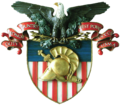
Athletics Army Black Knights • Army–Navy Game • Basketball (m) • Commander-in-Chief's Trophy • Football (Doc Blanchard, Earl Blaik, Glenn Davis, Pete Dawkins) • Ice Hockey (m) • Lacrosse (m) • Facilities (Christl Arena, Doubleday Field, Gillis Field House, Michie Stadium, Tate Rink)Campus Chapels (Catholic, Jewish, Old Cadet, Protestant) • Flirtie Walk • Grounds • Cemetery • Hayes Gym • Lusk Reservoir • Monuments • Plain • Thayer Hotel • Trophy Point • West Point LightHistory Academy History • Constitution Island • Fort Clinton • Fort Putnam • Great Chain • Kosciuszko's Garden • Redoubt FourPeople Alumni • "Class the stars fell on" • Notable non-grads • Master of the Sword • Superintendents (Current, Former) • Sylvanus ThayerTraditions Categories:- United States Military Academy
- Military history of the United States (1900–1999)
- 1915 in the United States
- American military leaders of World War II
Wikimedia Foundation. 2010.

